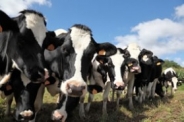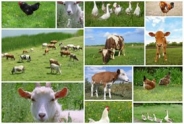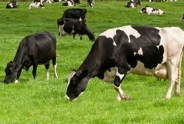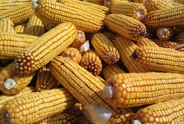Heat Detection
Libby Eiholzer, Bilingual Dairy
Northwest New York Dairy, Livestock & Field Crops
January 2, 2013
Watching cows for heat is a task that's often assigned to cow pushers, since they probably spend more time observing cows than anyone else on the dairy. They also spend time among cows during the night hours, when cows in heat tend to be most active. While their primary job is bringing cows to the parlor, they should understand just how important heat detection is.
Heat is the time period in which a cow can become pregnant if she is inseminated. It lasts from 6 to 30 hours, and the best time to breed is during the 12 hours of "true heat". If we waste an opportunity to breed a cow, we"ll have to wait 21 more days until the cow cycles into heat again. It's easy to waste many months in this way! On the other hand, breeding a cow that isn't in heat is a waste of semen.
There are many signs to help identify a cow in heat. The surest sign that a cow is in true heat is that she allows other cows to mount her. The secondary signs are shown sometimes by cows in true heat, but also when a cow is entering or leaving true heat. Some of these secondary signs are dirty flanks and a red and inflamed vulva with a clear mucous discharge. Cows in heat will also sniff the vulvas of other cows, bawl like a bull, walk faster, ride other cows, and give less milk than normal. The possibilities that a cow inseminated while entering or leaving true heat will become pregnant aren't very good, so it's worthwhile to pay close attention to cows that may be in heat.
Heat Detection Detección de Celo
Look for cows in heat Busque vacas en celo
The vulva is red and swollen La vulva está rosada e inflamada
The vulva has a clear mucus discharge La vulva tiene una descarga de moco claro
The cow allows other cows to mount her La vaca se deja montar
Sniffs vulva of other cows Olfatea la vulva de otras vacas
Bawls like a bull Vocifera como un toro
Detección de Celo
Buscar vacas en celo es un trabajo muchas veces asignado a los arreadores de vacas, como ellos pasan más tiempo observando a las vacas que cualquier otra persona en la granja. También pasan mucho tiempo con las vacas durante la noche, cuando las vacas en celo están más activas. Aunque su trabajo principal es llevar las vacas a la sala de ordeño, es importante que entiendan que tan importante es identificar las vacas que están en celo.
El celo es una temporada en que una vaca puede quedarse preñada al inseminarla. Solamente dura unas 6 a 30 horas, y hay unas 12 horas en que es más recomendable inseminarla (el celo verdadero). Si gastamos una oportunidad para inseminar una vaca, tendremos que esperar 21 días hasta la vaca cicla al celo otra vez. ¡Así es posible gastar muchos meses! Al contrario, inseminar una vaca que no está en celo sería una pérdida de semen.
Hay varios signos para ayudarnos a identificar una vaca que está en celo. El signo más seguro del celo verdadero es que la vaca se deja montar por otras vacas. Los signos secundarios están mostrados a veces por vacas en calor verdadero, pero también cuando están entrando o saliendo del celo verdadero. Algunos de estos signos secundarios son los flancos sucios y una vulva rosada, inflamada y con una descarga de moco claro. Las vacas en celo también suelen olfatear la vulva o la orina de otras vacas, vociferar como un toro, caminar más rápido, montar a otras vacas y dar menos leche que normal. Las posibilidades de que una vaca inseminada cuando está entrando o saliendo del celo quedaría preñada no son muy altas, así que vale la pena poner mucha atención a las vacas que podrían estar en celo.
Upcoming Events
Pasture Walk at C&H Farms of WNY, LLC
August 26, 2025
Akron, NY
C&H Farms is new to grazing beef cows. Come out to view, discuss, and learn what is working and what needs some adjusting.
Dairy Bovine Reproduction and Artificial Insemination Training Course en Espanol
October 14 - October 15, 2025
Join us for a two-day workshop with hands-on training that will be offered in Spanish in cooperation with Javier Cheang, Genex. Space is limited, register today!
Inaugural New York State Agritourism Conference
November 10 - November 11, 2025
Saratoga Springs, NY
SAVE THE DATE! Inaugural NEW YORK STATE AGRITOURISM CONFERENCE presented by Cornell Cooperative Extension Agritourism Program Work Team
Announcements
We're Hiring: Area Dairy Management Specialist
To apply:Please apply via Academic Jobs Online (https://academicjobsonline.org/ajo/jobs/30185).
Qualified candidates should submit a short cover letter, curriculum vitae, and contact information for three references.
Applications must be submitted by July 31, 2025.
For more information, please contact Peter Landre at ptl2@cornell.edu. Additional information about the Northwest New York Dairy, Livestock and Field Crops Team can be found at https://nwnyteam.cce.cornell.edu/.
Follow us on Instagram
See photos and reels of our most recent events and programs!Join us on Facebook!
Follow us on Facebook to get up to date posts about events, workshops and everything NWNY!Add us on LinkedIn!
Connect with us on LinkedIn to get more information about upcoming workshops and programs!





